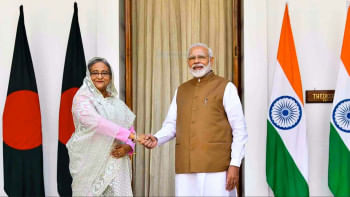Unpacking Bangladesh and northeast India’s untapped potential

Bangladesh and India share a 4,096km international border, 1,880km of which is with India's northeastern region (NER). India's NER is strategically positioned and might serve as the country's gateway to Southeast Asia. Bangladesh shares borders with Assam, Meghalaya, Tripura and Mizoram in the NER. With the exception of Meghalaya, all states have land and river borders with Bangladesh. The longest land and river-based boundaries with Bangladesh are in Tripura and Mizoram. Closer economic integration and connection with Bangladesh would diminish these states' economic isolation, while simultaneously strengthening their linkages with India's heartland.
The nexus between Bangladesh and the NER determines the current pattern of commerce between the two countries. Some important minerals are found in the NER which are in high demand in Bangladesh. Resources such as coal, limestone, stone chips, and bamboo are important NER exports to Bangladesh, while finished goods such as cement, plastic, goods, ready-made clothing, processed food, and soft beverages are key imports. This makes a compelling case for increased trade between the two regions.
Agartala is 1,650km from Kolkata and 2,637km from New Delhi through Shillong and Guwahati. The journey between Agartala and Kolkata via Bangladesh, on the other hand, is only about 550km. Furthermore, the average distance between Bangladesh's major cities and northeast India is 20km to 300km. As a result, Bangladesh is always considered crucial for NER's connectivity with mainland India by rail, road and river routes. Because of its strategic location, there are several opportunities for trade, transportation, commerce, and connection between Bangladesh and the NER. As a result, it is critical to map out some of the most important sectoral prospects.
The northeastern region is a source of around 63,000MW of hydropower energy. Bangladesh can benefit from the extra or underutilised power generated in the NER by bolstering its power supply. As a result, cooperation in this industry can benefit both regions. Connectivity with northeast India, namely the Seven Sisters, might be extremely beneficial to both parties. This aim could be served by establishing government-to-government (G2G) economic cooperation. Establishing G2G economic zones between Assam and Sylhet could help achieve this goal.
The first step towards increasing tourism between Bangladesh and the Seven Sisters will be to reopen all of the blocked border checkpoints to visitors. There are now only three border checkpoints along the states of Tripura and Meghalaya. Both must look into the possibility of adding more border checkpoints and developing infrastructure, including communication lines. Furthermore, the international airport in Sylhet can act as a link between the secluded people of the northeast and the rest of the globe. Given the enormous number of state-of-the-art hospitals and educational institutions on this side of the border, Bangladesh can also draw a large number of NER population for medical and educational tourism.

It is clear that both the administrations are committed to revive inland navigation between Bangladesh and the NER. However, there are obstacles to making efficient use of the waterways: heavy siltation, shifting channels, lack of needed water depth during the lean season, night navigation limits, and the absence of appropriate navigation, for example. These issues must be addressed for the mutual benefit of Bangladesh and India's NER.
To give access to subregional main cities and ports, the Bangladesh, Bhutan, India and Nepal Motor Vehicle Agreement (BBIN MVA) would substantially help the chances for cooperation. Under the BBIN MVA, Bangladesh and India should work collaboratively to increase cross-border trade with the NER.
During a meeting between Bangladesh Prime Minister Sheikh Hasina and India's External Affairs Minister S Jaishankar in Dhaka in April this year, the Bangladeshi premier offered India the use of Chattogram port when discussing the necessity for greater connectivity between the two neighbouring countries for mutual benefits. This presents a lot of exciting prospects for the two countries to collaborate closely. Bangladesh has the potential to be a major partner of India's efforts to increase trade in the region as the globe "pivots to Asia" and the Indian Look East policy changes into the Act East policy.
Both Dhaka and New Delhi would benefit from a larger role for northeast India. Because of its proximity to Southeast Asia and Bangladesh, the region has the possibility to serve as a bridge for India while also benefiting economically and entrepreneurially.
Dr Abantika Kumari is an assistant professor at the History Department of Allahabad College in Uttar Pradesh, India. She is also a researcher particularly focused on South Asia. She can be contacted at [email protected]

 For all latest news, follow The Daily Star's Google News channel.
For all latest news, follow The Daily Star's Google News channel. 










Comments